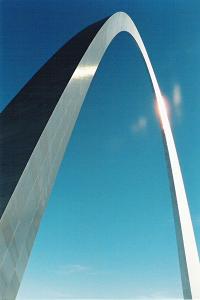Jefferson National Expansion Memorial
|
|
Stlouisarchnps.jpg
The Jefferson National Expansion Memorial is located in Saint Louis, Missouri near the start of the Lewis and Clark Expedition, and commemorates the Louisiana Purchase and settlement of the American West. It was designated as a National Memorial on December 20,1935, and is maintained by the National Park Service.
The memorial site consists of a 90 acre (0.36 km²) park along the Mississippi River on the site of the original city of St. Louis; the Old Courthouse, a former state and federal courthouse which saw the origins of the Dred Scott case; the Museum of Westward Expansion; and the Gateway Arch, a steel catenary arch that has become the city's emblem.
| Contents |
The Gateway Arch
Gateway_Arch_At_Night.jpg
In 1947, a group of civic leaders held a national competition to select a design for the main portion of the Memorial space. A young Finnish-American architect named Eero Saarinen won this competition with plans for a 590 foot (180 metre) catenary arch to be placed on the banks of the Mississippi River. However, these plans were modified over the next 15 years, placing the arch on higher ground and adding 40 feet (12 m) in height and width.
Saarinen developed the shape with the help of architectural engineer Hannskarl Bandel. It is not a pure inverted catenary. Saarinen preferred a shape that was slightly elongated and thinner towards the top, a shape that produces a subtle soaring effect, and transfers more of the structure's weight downward rather than outward at the base.
When Saarinen won the competition, the official notification went to his father, architect Eliel Saarinen, who had also submitted an entry.
The construction of the Arch began February 12, 1963 and was completed on October 28, 1965, costing less than US$15 million to build. US Vice President Hubert Humphrey and Secretary of the Interior Stewart Udall dedicated the Arch on May 25, 1968.
The Arch stands 630 feet (192 m) tall, and is 630 feet (192 m) at its widest point; by ordinance it is the tallest structure in the city. Its legs are equilateral triangles, narrowing from 54 feet (16.5 m) at the base to 17 feet (5.2 m) at the top. Each wall consists of a stainless steel skin covering reinforced concrete from ground level to 300 feet (91 m) or carbon steel and rebar from 300 feet (91 m) to the peak. The interior of the Arch is hollow and contains a unique transport system leading to an observation deck at the top. The interior of the Arch also contains two emergency stairwells in the event of a need to evacuate the Arch or if a problem develops with the tram system.
Visitor's center
Underneath the Arch is a visitor's center, entered from a descending outdoor ramp starting at either base. With the center is the Museum of Westward Expansion, exhibits on the history of the St. Louis riverfront, tram loading areas, a movie theater showing a documentary on the Arch's construction, and a movie theater with a rotating playlist.
Visitors should be aware that they will be required to pass through security checkpoints at each entrance to the Arch. They and their belongings will be screened before being allowed access to the visitor's center. Lines often form outside because of the security screenings, people should be aware of this especially during inclement weather conditions.
Tram
GatewayArchTramCar.jpg
From the visitor's center one may move to the either base of the arch and enter a unique tramway much as one would enter an ordinary elevator, through double doors. Passing through the doors the passengers in small groups enter a horizontal cylindrical compartment containing five seats on the sides of the cars and a flat floor. A number of these compartments are linked to form a train. These compartments each individually retain an appropriate level by rotating, this allows them to maintain the correct orientation while the entire train follows curved tracks up one leg of the arch.
There are two groups of these tramways, one on the north end and the other on the south end of the Arch. Each group of cars is made up of eight cars. The trip to the top of the Arch takes four minutes, and the trip back down takes three minutes. The car doors do have glass panes, so passengers are able to see the interior of the Arch during the trip.
Observation area
Near the top of the arch, a rider will exit the compartment and climb a slight grade to enter the arched observation area. Small windows, almost invisible from the ground, allow views across the Mississippi River and southern Illinois with its prominent Mississippian culture mounds to the east at Cahokia, and the city of Saint Louis and the Great Plains to the west.
ArchIntRvrFront.JPG
QuickBirdStLouisClip.jpg
GatewayArchSouthTramEntrances.JPG
External links
- Official site (http://www.nps.gov/jeff/)
- Jefferson National Expansion Memorial Pictures (http://www.nationalparksgallery.com/parks/Jefferson-National-Expansion-Memorial)
- Gateway Arch tourism site (http://www.gatewayarch.com)
- Google Satellite (http://maps.google.com/maps?ll=38.62463240,-90.18462694&spn=0.007,0.014)
Template:Geolinks-US-buildingscaleda:Gateway Arch de:Gateway Arch

